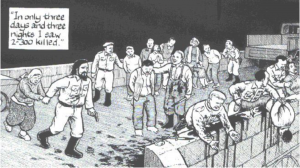Field trip to University Archive
Bonjour readers,
Through shows I watched on television, I had a rough idea about the archive. In my mind, I thought the interior of the archive is dark and pack with thick binders and books. However, when we came to the University Archive under the IBLC, I learned about the distinguish features of archives compare to libraries. Also we have deep insight on the author of Obasan, Joy Kogawa through the fonds and artifacts in it.
The Archive admin gave us a brief introduction on basic distinctions between the libraries and archives. In generally, the libraries are occupy with secondary resources like books which commonly gathering and expand on first hand information to create further analysis base on the original documents. These first hand collections are primary resources that compose archives, it can be in the form of letters, draft, newspaper article. On another hands, most of the collections placed in libraries are artificial made. Books and Magazines have nice covers, printed pages and released by publishers which means they can be duplicate for sell purpose. At the same time, the collections in archives are unique and rare of copies. The documents in fonds are collect naturally from readers, authors, press or anything relates to works of the artists. Therefore, every collections are originals then there is no way to find it in other places, just like artworks in museums.
Afterwards, we got a chance to look at the folders from the Kogawa’s fonds. I was amaze about how many files just relate to her works and each folder’s artifacts are differ from another one. The artifacts I looks at included the letters of students response to Kogawa’s children’s book “Naomi on the road”; Oxford University press and other newspaper comments on her children novels; and a thin folder with government officials including prime minister letter about “Obasan”. Most for the artifacts were created in 80’s which present images of the generation and their way of living. As far I know, the “Naomi on the road” is one of the children book that Joy Kogawa wrote. The book depict a girl name Naomi in some degree the portrait of Kogawa herself, during the internment camp in a small valley far away from Vancouver. 
Children response with very cruelly words in the letter to the author and freely express their feeling about story characters. The other folder contained newspaper articles and letter of the Oxford press give me some details of the public response of the book. Kogawa’s work received many positive feedbacks from these reports and being praise for retrieve and restore of the historical tragic for Japanese Canadian during WWII internment. Last but not least, Kogawa had sent her copies of “Obasan” to officials of the time like governor of Ontario, members of monument broad, even the prime minster Pierre sent thanks notes back to her (Trudeau 1981). Aren’t like the “Aunt Emily” who is the activist that always enthuse speak out against government for the compensation of Japanese Canadian. Joy Kogawa use her peaceful discourse via the fictional novel “Obasan”, to reveals a national misstep and let the government confront the situation. The novels written by Kogawa having influences in wide-age range of Canadian by narrate the mistreated of Japanese Canadian in British Columbia during WWII and she wants the society avoid recurrence of similar mistake.
Work cited:
Trudeau, Pierre. Special Letters form P Trudeau, W. DAVIS, Monument Broad. Toronto: Lester & Orpen Dennys Limited. 24 July, 1981. Box 58 File 7. Joy Kogawa fonds. University of British Columbia Library Rare Books and Special Collection, Vancouver Canada.

